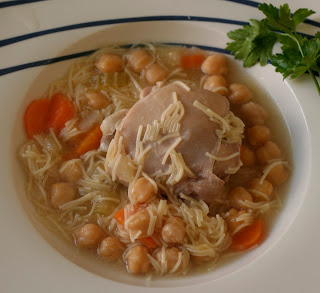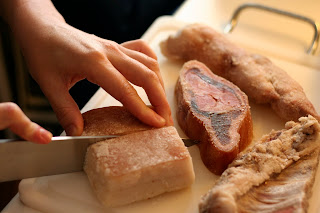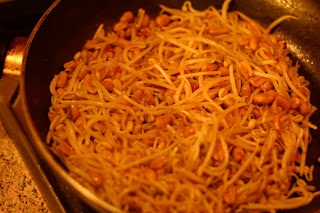
I don't know how many basic types of cake there are in European cuisine. (I wonder if anyone has ever tried to produce a typology of them, a bit like those claims that there are only seven plots in the whole of world literature.) One very simple version involves mixing eggs, sugar and flour, and possibly adding something else for extra flavour (fruit or chocolate, for example). There's no reason why the carbohydrate element has to be provided by flour. I already have a recipe for an orange cake with polenta, and it occurred to me that the polenta could be replaced by couscous. The result was very successful - moist and with a good texture, without being crumbly. The overall flavour is quite intense, as the whole oranges give it an almost marmalade-like bitterness, so probably one to serve to grown-ups. I think it would be good hot with some vanilla ice cream.
Ingredients
3 large oranges
6 eggs
150 g couscous
150 g ground almonds
300 g demerara sugar
Method
- Place two of the oranges in plenty of water, bring to the boil and simmer for one hour. Drain the oranges, and allow to cool.
- Preheat the oven to 180°C, and line and grease a springform cake tin.
- Halve the oranges and puree in a food processor.
- Transfer the orange puree to a mixing bowl, and beat in the eggs, couscous, almonds and 250 g of the demerara sugar. (Set aside the remaining 50g to make orange syrup with.)
- Pour the mixture into the tin, bake for 1 hour and remove from the oven.
- Meanwhile, juice and zest the remaining orange.
- Make a syrup by gently heating the remaining 50g of sugar, zest and juice for a few minutes until the sugar is dissolved. Strain through a tea strainer to remove the zest.
- While the cake is still in the tin, prick it all over with a toothpick to allow the syrup to soak in, and pour the syrup over it.
My video game career never really got beyond Pac-Man. The next game I tried was Frogger, but I struggled with its complexity. I don't know how much money I had wasted (and how many electronic frogs I drowned) before I finally realised that although I had to navigate my way across the road by jumping into the gaps between the oncoming vehicles, I had to cross the river by jumping onto the logs and not into the gaps between them. It struck me as a bit arbitrary and I gave up at that point. After all, surely frogs can swim and don't need to hitch rides on logs.












